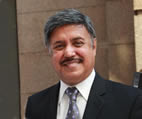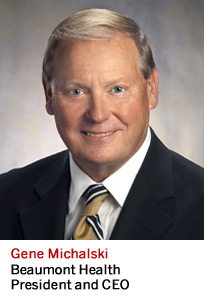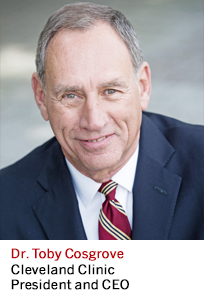Auto logout in seconds.
Continue Logout This interview with Ram Raju, President and CEO at New York City Health and Hospitals Corporation and former CEO of Cook County Health and Hospitals System, was conducted by Eric Larsen, managing partner, and condensed by Kate Ackerman, contributing editor.
This interview with Ram Raju, President and CEO at New York City Health and Hospitals Corporation and former CEO of Cook County Health and Hospitals System, was conducted by Eric Larsen, managing partner, and condensed by Kate Ackerman, contributing editor.
Question: Ram, you're a surgeon and spent a long time running a private practice in a unique part of the country—living in Staten Island and operating a practice in Brooklyn. What drew you to that work?
Ram Raju: I'm a first-generation immigrant to this country. I came here because it's probably one of the best health care [education systems]—it's where you learn the best and you do the best. When you become a young surgeon, you want to publish papers, you want to teach students, you want to get a faculty appointment, and you want to be a chief of a department. So I did all those things.
However, I never really looked at the huge aspect of health care outside of that. I kind of lived in a cocoon to some extent.
Q: So how did you make the transition to hospital administration?
Raju: My first exposure to administration was in the 1990s, when I was working in a not-for-profit hospital in Brooklyn. Since my hospital decided to remain independent and not join a major academic medical center, they brought in a consultant to tell them how to improve and cut costs.
The consultant recommended cutting the number of operating rooms by 50%. As the leader of the Department of Surgery, I found it extremely difficult to do that. There were a lot of private doctors who wanted to operate at 8:00 in the morning. If I cut my capacity to give 8:00 a.m. timeslots by 50%, those private physicians were going to take their patients and go somewhere else.
Naturally, if they don't operate at your facility, you don't get the money.
So I decided my hospital needed a trauma center to keep my operating rooms busy. I went to my board, and they said, "You're crazy." Trauma centers aren't supposed to make money. But because I lived in Brooklyn for many years, I understood the geography and the topography of Brooklyn much better. This hospital was in the middle of two of the most dangerous highways the country. I knew that if we opened a trauma center, we'd get mostly motor vehicle accidents, and motor vehicle patients bring money. It became a very profitable trauma center.
My break-even was 500 admissions from the trauma center. The first year, we had about 1,600 admissions. It's probably one of the very few profitable trauma centers in the country.
That's when I got more interested in hospital administration.
A revelation about health care disparities
Q: Why did you choose to spend your hospital administration career in the public system?
Raju: My revelation came when [the Institute of Medicine] wrote the primer on unequal treatment. That primer opened my eyes. It said the greatest country in the word—the richest and the most advanced country in the world—still has people in certain parts of the country who cannot get health care. People die of advanced diseases because they simply cannot get to a doctor because of where they live or they don't have the money, they don't have insurance or they live on the wrong side of the train tracks.
Honestly, I was extremely shocked to think about it because I had always looked at health care through my own eyes. So that was the time I decided to move into public hospital systems. It was 2002, and I never left. This is my 12th year in the public system.
People thought I was absolutely nuts because I took a job that paid maybe 10% of my previous salary. But health care disparities is a passionate subject for me. I believe strongly that health care is a fundamental right. It should be a human right. And, it should be a civil right. I don't think we should let people either go bankrupt or die because they happen to live in the wrong part of the city or they are the wrong color or they don't have enough money.
Funding public health systems: 'You're not doing this as a charity. It's in your self-interest.'
Q: How do you respond to those people who want to cut public health system funding?
Raju: The fundamental issue that people need to understand is that your health depends on my health. Recently, I was asked to speak at the Chicago City Club and sat next to a very high-powered lawyer, and he said, "Look I don't understand why we even need a public system. I'll never use the public system. So why should I have to fund it with my tax dollars?"
So I told him two things. First I said, "You can go to the most expensive restaurant in the North side of Chicago and order a $100 steak. But if you just look behind the door, the person who cooked your steak is probably my patient in the public system. So you could buy the $100 steak, but if that guy's not well, you're going home with his problems. The people who rely on the public system are the people that take care of your children, clean your house and cook your food. Self-interest demands that you keep them well to keep yourself well."
Then I said, "God forbid if you ever happen to get into a motor vehicle accident somewhere on the Eisenhower expressway, you're going to be transported to the public system. Are you willing to give up your life or be paralyzed for the rest of your life because the public system didn't have funding? You have to understand, you're not doing this as a charity. It's in your self-interest."
Fiscal responsibility in safety-net hospitals
Q: How have you been able to draw attention to the plight of the underserved, while also having incredible fiscal discipline—you cut the county's patient care costs by $101 million during your tenure—and instituting some real rigor into the cost structure.
Raju: First and foremost, using sound financial principles does not mean that you are detracting from the hospital's mission. It's perfectly okay to make money in the system. It's good. You can get up and say, "I'm the public system. Guess what, I lost $200 million, but I'm mission-oriented." It simply shows that you are mission-oriented, but you're a lousy administrator.
From a social justice perspective, if I don't collect $1, that $1 worth of service is denied to the next guy to come through the door. When you frame it as a social justice issue, people say, "Oh, it makes sense to collect money because if you don't collect money, you won't be able to take care of the next patients."
Lessons learned: Moving to a new health system
Q: What can you extrapolate from your Cook County experience and apply to New York?
Raju: You know, I was from New York, so I know the system well. There are two major issues. One is that they are in financial trouble because the tragedy related to Hurricane Sandy basically put a huge dent in their income stream for eight to 10 months.
The second is that the health care delivery system has changed completely. The systems need to quickly adapt. The problem with a big system like ours is that it's like a huge cruise ship. You can't just turn them on a dime because you'll flip over. But you can try to move it in the right direction.
A public system is about managing priorities. You have to really figure out first and foremost how to keep the system afloat before you can change it. So that is where the tactfulness comes in.
That is going to be the biggest challenge we're going to face. And, we don't have much time because the entire industry around us is changing very fast, and they are much more nimble.
Q: How are you different personally as a CEO now assuming the reins in New York than if you hadn't gone to Chicago and had assumed the reins two years ago?
Raju: I think Chicago has made me stronger. It's taught me a lot about how to get things done. Chicago, as you probably can imagine, is a highly political town. So I learned to be able to manage the priorities of different folks. It made me a better leader, a better listener, I understand things better. I actually kind of aged very quickly in the last two-and-a-half years at Cook County, but I also learned a lot. You know, everybody has got good ideas, but it's really how you implement them. It is been a great educational experience for me.
I am really in much better shape and prepared than I was two-and-a-half years ago. I also think when you go outside, it gives you a little different perspective.
Changing the two-tier health care system
Q: I'm going to ask you to improvise a bit. Write for me the press release on Jan. 1, 2017, for New York City Health and Hospitals Corporation. What does it say?
Raju: I hope that it'll show that the two-tier health care system in New York will become one tier. If you are poor right now and you have a health care problem, then you go to the public system. And if you are rich, you go to rich, private institutions. So hopefully by 2017, we're able to merge them into one system.
But it will take a lot of work. We simply think that creating more access, opening more clinics and making medication available at a lower cost will somehow improve people's health status. But health care depends on other factors, like education, jobs, and public safety. If you really want to improve population health, you have to tackle all of them.
As an organization, we have to really figure out to do population health and how to end this two-tier health care system.
Q: How does the Affordable Care Act play into ending the country's two-tier health care system?
Raju: The Affordable Care Act will become purely the biggest insurance entitlement program in the country unless we do three things to make it work: access reform, delivery system reform, and payment reform.
The ACA should be followed by access reform. We need to ensure that we have enough providers. All the trade associations need to acknowledge and support the increased role the mid-level providers play in this access reform and allow them to practice at the top of the license, Health care providers' job description and job scope need to change.
And then we need health care delivery system reform. If a person comes into the emergency department with a primary care problem, we should be able to tell them, "Don't wait in the emergency department, walk across the street, there is a clinic that can treat you." But right now, we're not allowed do that because of EMTALA rules.
And, last but not least, we need payment reform. Payment should support health care as opposed to sick care.
So, if you don't do payment reform, if you don't do delivery system reform, if you don't do access reform, the ACA will be one of the most expensive entitlement programs we've ever created.
Get more lessons from the C-suite
See the Daily Briefing's archive of must-read interviews with other top hospital and health system leaders, including:
 How an ACO champion—now a health system CEO—plans to put one in every market
How an ACO champion—now a health system CEO—plans to put one in every market
Richard Gilfillan explains how he viewed health care delivery as the first head of the Center for Medicare and Medicaid Innovation—and how that changed when he became the CEO of Trinity Health. Read our interview with Richard.
How an English major became a hospital CEO at age 29
In a Q&A with the Daily Briefing, Sandra Bruce explains what she's learned in her decades as a hospital CEO, how two systems overcome bumps in the road to become Presence Health, and what it means to "Lean In" in health care. Read our interview with Sandra.
 How to prove a boss wrong when he thinks you're the second choice? Do what this CEO did.
How to prove a boss wrong when he thinks you're the second choice? Do what this CEO did.
Today, Gene Michalski is the first CEO of Beaumont Health, a newly formed $4 billion health system. But almost 40 years ago, when Michalski applied for the position that launched his career…he was originally the second choice. In an interview with the Daily Briefing, Michalski shares his secret to convincing a wary leader to hire him, how it influenced his own management style, and how he sees the industry. Read our interview with Gene.
 Cleveland Clinic CEO's single best tip on building a career: 'Shamelessly steal.'
Cleveland Clinic CEO's single best tip on building a career: 'Shamelessly steal.'
Toby Cosgrove explains how—despite barely getting into med school—he's now the head of the Cleveland Clinic, how he sees the industry, and how one tactic is key to his management success. Read our interview with Toby.
And it's never too early to start grooming a great manager. See our Succession Management Implementation Guide to ensure you deliberately chose your future leaders—don’t let circumstances choose them for you.
Don't miss out on the latest Advisory Board insights
Create your free account to access 1 resource, including the latest research and webinars.
Want access without creating an account?
You have 1 free members-only resource remaining this month.
1 free members-only resources remaining
1 free members-only resources remaining
You've reached your limit of free insights
Become a member to access all of Advisory Board's resources, events, and experts
Never miss out on the latest innovative health care content tailored to you.
Benefits include:
You've reached your limit of free insights
Become a member to access all of Advisory Board's resources, events, and experts
Never miss out on the latest innovative health care content tailored to you.
Benefits include:
This content is available through your Curated Research partnership with Advisory Board. Click on ‘view this resource’ to read the full piece
Email ask@advisory.com to learn more
Click on ‘Become a Member’ to learn about the benefits of a Full-Access partnership with Advisory Board
Never miss out on the latest innovative health care content tailored to you.
Benefits Include:
This is for members only. Learn more.
Click on ‘Become a Member’ to learn about the benefits of a Full-Access partnership with Advisory Board
Never miss out on the latest innovative health care content tailored to you.
